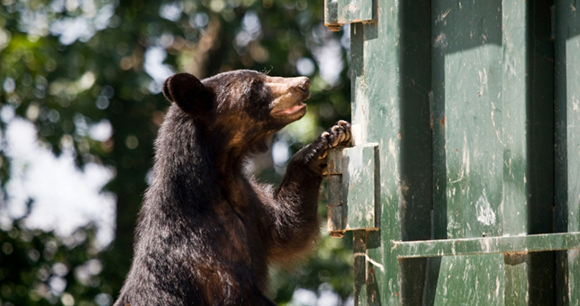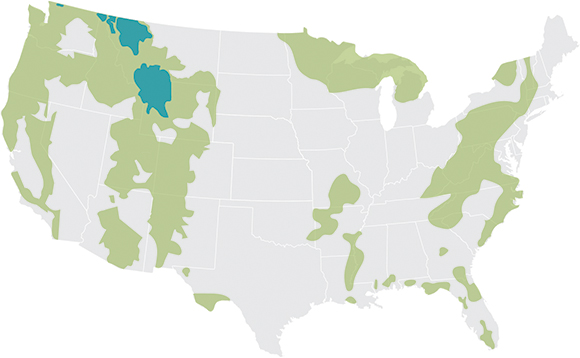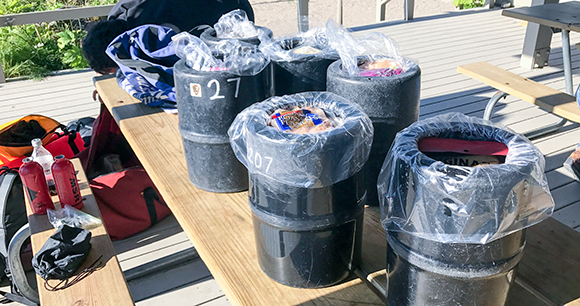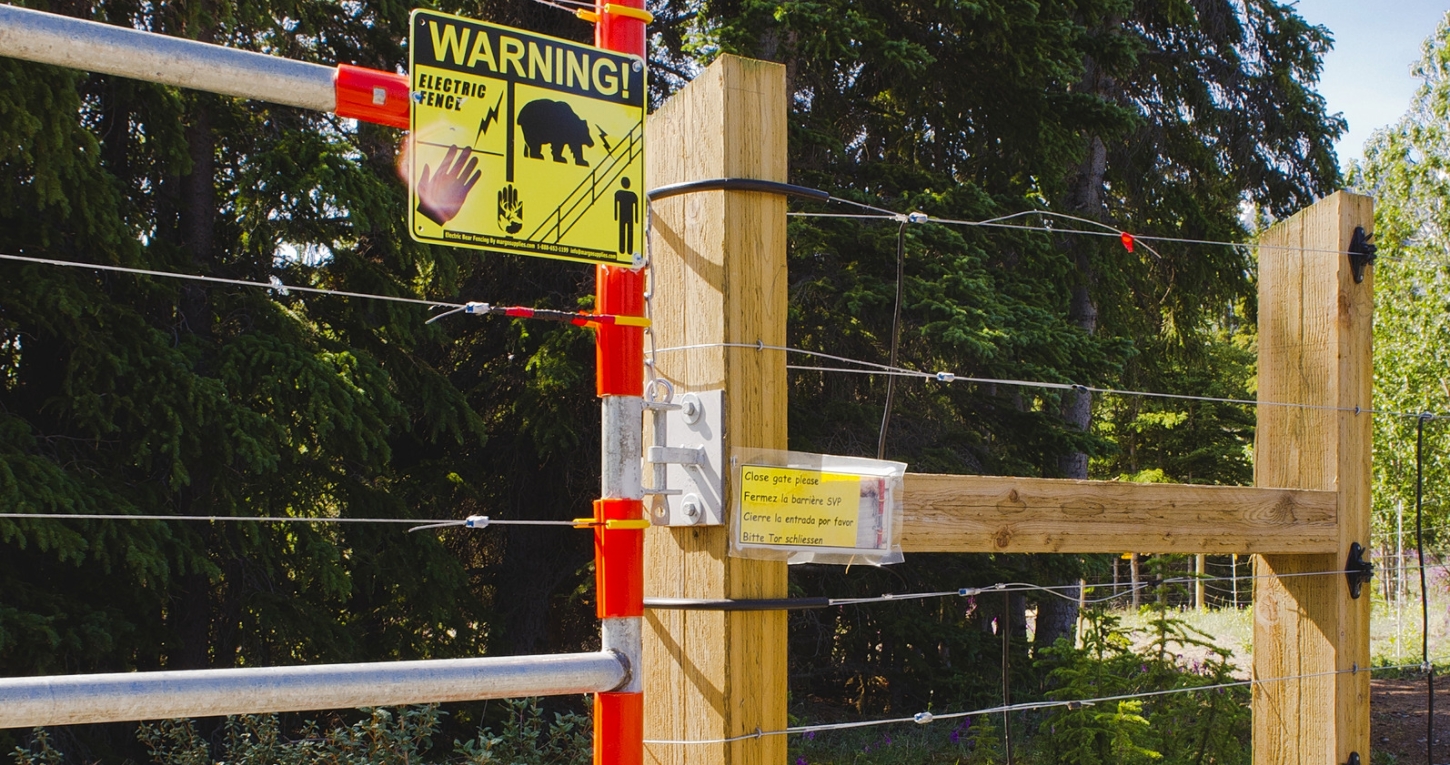
Historically, grizzly bears (Ursus arctos horribilis) inhabited most of the western contiguous United States, while black bears (Ursus americanus) were common in forested areas throughout the country. However, the combination of westward expansion by European settlers and state and federal predator extermination campaigns slashed the populations of both species. Today, an estimated 2,000 grizzlies occupy a mere 6 percent of their historical range in the contiguous states, while an estimated 300,000 black bears occupy just 50 percent of theirs. Grizzly bears roam portions of the Northern Rocky Mountains, while black bears inhabit large swaths of the West, western Great Lakes region, and Appalachia.

Black and grizzly bears have evolved remarkable physiological characteristics. They are highly intelligent and inquisitive—adept problem solvers who can teach learned behaviors to their young. They also have incredibly powerful noses and can pick up strong scents from miles away. In addition, bears are omnivores and can subsist on a wide variety of foods, including grasses, leaves, flowers, berries, nuts, seeds, insects, carrion, fish, rodents, and, occasionally, ungulates such as moose, elk, and deer (most often the very young or infirm). Indeed, one study found that grizzly bears in the area around Yellowstone National Park eat at least 266 different plant and animal species.
These capabilities serve bears well in the wild because they must find and consume enough food and accumulate enough body fat to sustain them in their winter dens for up to six months. Indeed, during the late summer and fall, bears will spend up to 20 hours a day locating and ingesting an enormous number of calories—as many as 20,000 per day—from whatever sources they can find.
These same traits, however, can sometimes get bears into trouble with humans. Bears’ intelligence, curiosity, powerful noses, dietary flexibility, and voracious appetites mean that they can easily discover, and will readily investigate, potential sources of calories in or near human habitations—including campgrounds, agricultural operations, and urban areas. And once bears learn to associate these places with food rewards, they are more likely to return, come into repeated conflicts, become habituated to people (and thus unsuitable for relocation), and be killed as a result.
Further, as the weather cools and winter approaches, bears’ urgent need to focus their attention on finding food means that they may be more easily startled by unsuspecting humans and act defensively by charging. Of course, bear attacks are extremely rare. Yellowstone National Park, for instance, calculates that the chances of being injured by a grizzly bear are approximately 1 in 2.7 million visits. Similarly, over more than a century (between 1900 and 2009), there were fewer than two fatal black bear attacks per decade in the United States. But when humans frighten bears, or inadvertently lure them too close, people and bears can be hurt or killed.
Avoiding Conflicts with Bears
Both grizzly and black bears usually avoid humans and human communities. However, in many areas, expanding human development is encroaching ever further into bear habitat, while in some places, recovering bear populations are expanding back into their traditional territories, bringing more bears into contact with people. In areas where humans and bears overlap, thousands of conflicts occur each year, and hundreds of bears are killed as a result. These deaths are all the more tragic because most human-bear run-ins are avoidable.
Fortunately, a wide variety of nonlethal tools and strategies can be used to deter bears from coming into conflict with humans and keep people, property, and bears safe. To avoid property damage and harm to humans and bears, consider the following tips, techniques, and guidelines for minimizing negative human-bear encounters.
Bears in the Backcountry
Each year, millions of recreationists hike, mountain bike, hunt, fish, and camp on public lands inhabited by bears. All of these activities risk bringing humans and bears into close proximity. To avoid conflicts, follow these best practices:
- When recreating in bear country, travel in groups of three or more people, and talk or make noise to alert bears to your presence.
- Carry bear spray, and know how to use it.
- Do not leave packs or bags containing food unattended.
- When camping, store food, garbage, and other potential bear attractants (even toothpaste!) well away from tents—in vehicles, bear-proof food storage boxes or lockers, or bear-resistant containers, or hanging from bear poles or tree branches at least 10 feet off the ground and 4 feet from the trunk.

Bears and Agriculture
Bears sometimes prey on unprotected cattle, sheep, pigs, chickens, and other livestock. They may also forage on crops such as corn and oats, as well as the honey, bees, and larvae in commercial beehives. This can mean injury or death to vulnerable domestic animals, economic losses for farmers and ranchers, and lethal removal of bears. Fortunately, there are many ways to protect agricultural resources from bears:
- Electric fencing can be installed around livestock pastures, crop fields, and apiaries. When energized to 7,000 volts or higher, this tool is a highly effective bear deterrent.
- Sites where ranchers pile the carcasses of dead livestock—known as bone piles or bone yards—are major attractants, and can bring bears and other predators into close proximity with live cattle or sheep, increasing the risk of depredation. Removing carcasses lowers the likelihood of conflict.
- Herders or riders on horseback can monitor groups of cattle and sheep, keep the herds bunched together to provide greater safety in numbers, remove sick animals, identify carcasses for removal, add human presence as a deterrent against predators, and identify carnivore signs and presence—all of which can help avoid depredation. Motion-activated scare devices that emit loud sounds or bright lights when triggered can be installed near livestock pastures to deter bears and other predators. Scare devices work best when they are regularly moved and different types are used, to avoid habituation.
Bears in Town
Urban areas offer a host of attractants that can lure bears into parks, streets, alleyways, and back yards. They include garbage, bird feeders, fruit trees, vegetable gardens, berry bushes, back yard chickens, dog food, barbeque grills, and compost piles. Best practices to avoid conflicts include the following:
- Using a bear-resistant garbage container, and only setting it out on waste collection day
- Encircling attractants such as gardens, compost piles, and fruit trees with electric fencing, and harvesting or removing ripe berries, vegetables, and fruits
- Cleaning barbeque grills thoroughly after each use and storing them inside a garage, shed, or other secure structure
- Removing bird feeders when bears are active; even if a feeder is empty or inaccessible, bears may still be attracted to the smell In addition, you can help reduce human-bear conflicts in your community by working with local officials or wildlife managers to distribute educational resources to residents, provide bear-resistant garbage containers, or enact ordinances designed to keep people and bears safe. Websites created by organizations such as the Get Bear Smart Society, BearWise, and the Interagency Grizzly Bear Committee offer helpful guidance and resources for coexisting with bears in urban and rural settings.

In addition, you can learn about steps communities in Montana, Wyoming, Idaho, and Colorado have taken to live with bears—and what actions AWI has recommended—in a letter we sent to city officials in Bozeman, Montana.
Bears are typically shy, reclusive creatures who want nothing to do with humans. However, their critical need, and extraordinary ability, to find food can draw them into conflicts with humans in the woods, around the farm, and at home. With some forethought, creativity, and basic understanding of bear behavior, we can prevent the majority of human-bear run-ins, keep bears and people safe, and ensure that bears remain—and thrive—in the wild.